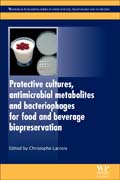
Protective Cultures, Antimicrobial Metabolites and Bacteriophages for Food and Beverage Biopreservation
Lacroix, C.
Consumers favour foods with fewer synthetic additives, but products must also be safe to eat and have a sufficiently long shelf-life. Biopreservation, the use of a product's natural microflora and its antibacterial products for protection against pathogens and spoilage, is a method of growing interest for the safe production of high quality minimally-processed foods. This book provides an essential overview of key topics in this area.Initial chapters review central aspects in food biopreservation, including the identification of new protective cultures and antimicrobial culture components, existing commercial fermentates including nisin and natamycin and the potential of novel fermentates and bacteriophages to improve food safety. Part II concentrates on the use of protective cultures, bacteriocins and bacteriophages to control the carriage of pathogenic microorganisms in food animals and to modulate human gut microflora. Chapters in the final section of the book review biopreservation of different types of foods, including milk and dairy products, fermented meats, fresh seafood and fruit. A review of active packaging for food biopreservation completes the volume.Edited by a leading expert, Protective cultures, antimicrobial metabolites and bacteriophages for food and beverage biopreservation is a fundamental reference for researchers and food industry professionals working to ensure the safety of the food supply. Reviews the central aspects in food biopreservation, including the identification of new protective cultures and antimicrobial culture componentsExamines the use of protective cultures, bacteriocins and bacteriophages to control the carriage of pathogenic microorganismsProvides an overview of the biopreservation of different types of foods, including milk and dairy products, fermented meats, fresh seafood and fruit INDICE: Part 1 Food biopreservation: Identifying new protective cultures and culture components; Antifungal lactic acid bacteria and propionibacteria; Nisin, natamycin and other commercial fermentates; The potential of lacticin 3147, enterocin AS-48, lacticin 481, variacin, and sakacin P; The potential of reuterin produced by Lactobacillus reuteri as broad spectrum preservative; Bacteriophages and food safety. Part 2 Applications of protective cultures, bacteriocins and bacteriophages in food animals and humans: Reducing carriage of foodborne bacterial pathogens in poultry; Reducing carriage of foodborne pathogens in cattle and swine; Controlling fungal growth and mycotoxins in animal feed; Biological control of human digestive microbiota using antimicrobial cultures and bacteriocins. Part 3 Applications of protective cultures, bacteriocins and bacteriophages in foods and beverages: Applications in milk and dairy products; Applications in fermented meat products; Applications in seafood and seafood products; Microbial applications in the biopreservation of cereal products; Biological control of postharvest diseases in fruit and vegetables; Biological control of pathogens and post-processing spoilage microorganisms in fresh and processed fruit and vegetables; Wine making; Control of mycotoxin contamination in foods using lactic acid bacteria; Active packaging for food biopreservation.
- ISBN: 978-0-08-101475-2
- Editorial: Woodhead Publishing
- Encuadernacion: Rústica
- Páginas: 536
- Fecha Publicación: 30/06/2016
- Nº Volúmenes: 1
- Idioma: Inglés
